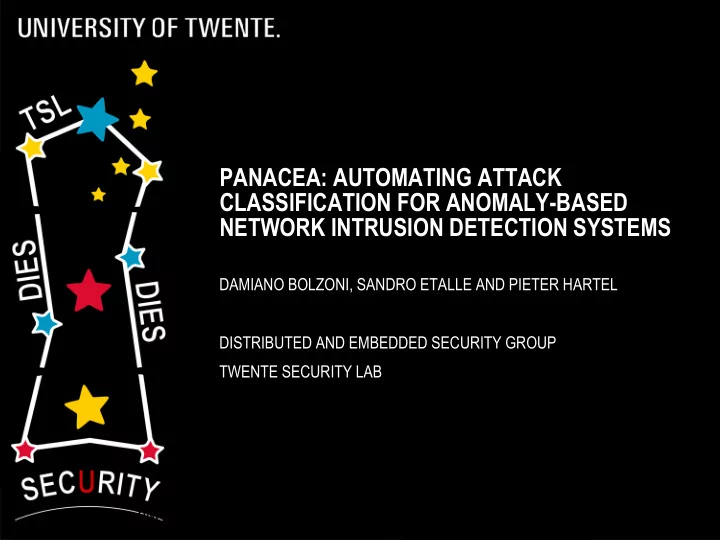

PANACEA: AUTOMATING ATTACK CLASSIFICATION FOR ANOMALY-BASED NETWORK INTRUSION DETECTION SYSTEMS DAMIANO BOLZONI, SANDRO ETALLE AND PIETER HARTEL DISTRIBUTED AND EMBEDDED SECURITY GROUP TWENTE SECURITY LAB
10+ YEARS OF RESEARCH OVER ANOMALY DETECTION… � Sadly though, few commercial implementations � most of them use “behavioral-based” anomaly detection → catchy words to say they detect portscans and DDoS… � others promise “protocol-based” anomaly detection → only a few HTTP attacks will use “Content-Length: -1”… � What went wrong? Where is the anomaly-based Snort ? Damiano Bolzoni 01/10/2009
IT’S A HARD LIFE IN THE REAL WORLD FOR AN ANOMALY-BASED IDS… � Training sets are not “clean by default” � Threshed values must be manually set next presentations in this session � Monitored systems “tend” to change over time � Alerts must be manually classified lack of usability → nobody will deploy such an IDS Damiano Bolzoni 01/10/2009
WHY ALERT CLASSIFICATION SHOULD BE AUTOMATED? � Use alert correlation/verification and attack trees techniques � so far, only available for signature-based IDSs � Automatic countermeasures activated based on attack classification/impact � block the source IP in case of a buffer overflow � wait the next action in case of a path traversal � Reduce the required user knowledge and workload � less knowledge and workload → less €€€ Damiano Bolzoni 01/10/2009
PANACEA AUTOMATIC ATTACK CLASSIFICATION � Idea: � attacks in the same class share some common content � Goals: � effective � > 75% of correct classifications, with no human intervention � flexible � allow both automatic and manual alert classification in training mode � allow pre- and user-defined attack classes � allow users to tweak the alert classification model Damiano Bolzoni 01/10/2009
PANACEA INTERNALS Damiano Bolzoni 01/10/2009
ALERT INFORMATION EXTRACTOR � Uses a Bloom filter to store occurrences of n-grams � data are sparse, few collisions � can handle N-grams (N >> 3) � Stores thousands of alerts, for “batch training” + ALERT CLASSIFICATION (manually or automatically provided) Damiano Bolzoni 01/10/2009
ATTACK CLASSIFICATION ENGINE � Two different classification algorithms � non-incremental learning, more accurate than incremental ones � incremental learning is “simulated” by using batch training � process 3000 alerts in less than 40s � each bit of the BF is an analysis dimension � Support Vector Machine (SVM) � black box, users have a few “tweak” points � RIPPER � generates human-readable rules Damiano Bolzoni 01/10/2009
BENCHMARKS AUTOMATIC MODE - DATASET A � 3000+ Snort alerts � pre-defined alert classes (10) � alerts generated by Nessus and a proprietary VA tool � no manual classification � cross-folding validation Damiano Bolzoni 01/10/2009
BENCHMARKS MANUAL MODE - DATASET B � 1500+ Snort web alerts � alerts generated by Nessus, Nikto and Milw0rm attacks � attacks are manually classified (WASC taxonomy) � cross-folding validation Damiano Bolzoni 01/10/2009
BENCHMARKS MANUAL MODE - DATASET C � Training set: � Dataset B � Testing set: 100 anomaly-based alerts � alerts have been captured in the wild by our POSEIDON (analyzes packet payloads) and Sphinx (analyzes web requests) Damiano Bolzoni 01/10/2009
BENCHMARKS SUMMARY � SVM performs better than RIPPER on a class with few samples (~50) � RIPPER performs better than SVM on a class with a sufficient number of samples (~70) � SVM performs better than RIPPER on a class with a high intra-class diversity and when attack payloads have not been observed during training Damiano Bolzoni 01/10/2009
CONCLUSION & FUTURE WORK � Panacea fulfills our goals � however, it works only in combination with payload-based NIDSs � Panacea 2.0 � improved classification � a 2 nd order polynomial for SVM increases accuracy to 99% but is x50 slower! � combining SVM and RIPPER when training samples are scarce � apply to alert verification � non-relevant true positives and false positives Damiano Bolzoni 01/10/2009
QUESTIONS ? Damiano Bolzoni 01/10/2009
Recommend
More recommend